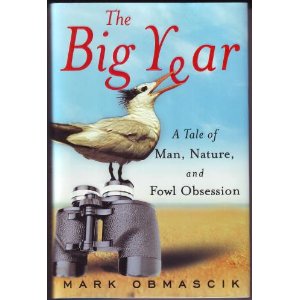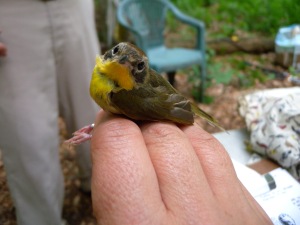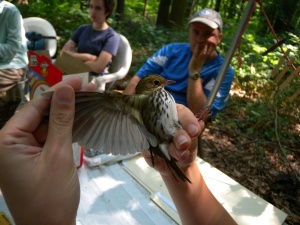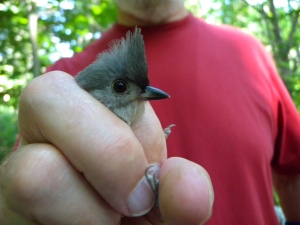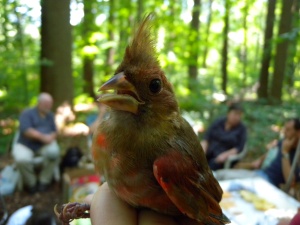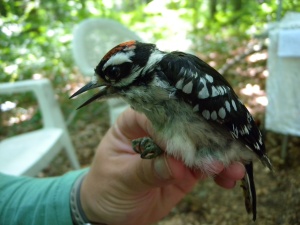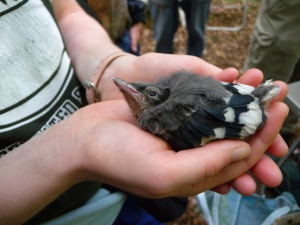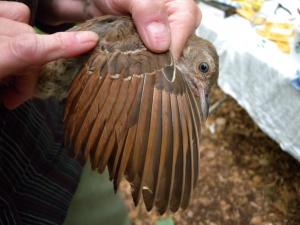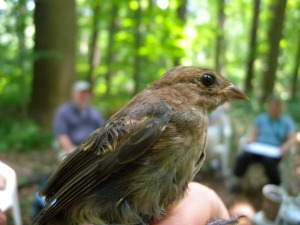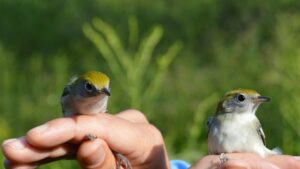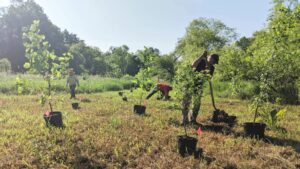Even with the warm, muggy weather of last week, we still noticed a major shift in Rushton’s migratory visitors. The catbirds are of course still congregating, but the wonderful warblers are waning, the first of the thrushes are traveling through, and even a solitary White-throated Sparrow was spotted. Could that mean the jolly Dark-eyed Junco will soon join the jamboree?

Last week marked several firsts for our banding station for this Fall season. We banded the first White-throated Sparrow and the first couple of Gray-cheeked Thrushes of this fall. More of them are sure to follow according to our records from last fall. We also banded our very first ever Rose-breasted Grosbeak! He was a young male born this year as evidenced by his brown plumage and traces of red on his breast and underarms. The adult males are glossy black with white and a brilliant red patch on their breasts that looks to me like they just spilled red wine on their good suits. Along with the thrushes, this grosbeak is merely passing through on his way to Central or South America. The White-throated Sparrow could very well be with us for the remainder of the winter, or he may travel a bit further south in the U.S. All three of these species are potentially coming from distant and remote forests of Canada, even as far north as the edge of the tundra in the Gray-cheeked Thrush’s case. Wouldn’t you just love to see the wild landscapes that he has seen and hear his ethereal summer voice spiraling through the north woods?

On Thursday, the PA Young Birders (PAYB) got to meet our fabulous fall migrants up close and personal! With 50 kids total, there were actually more kids present than birds that day; the children came from PAYB, Upper Mainline Y, and other nearby areas and ranged in age from 8-18 years. The bird catch consisted of several chickadees, lots and lots of Gray Catbirds (our bread and butter bird as Doris says), a couple of handsome Eastern Towhees, and only a Common Yellowthroat and two Black-and-whites representing the warblers. The “compost net” caught our last excitement of the day, which was an attractive Eastern Phoebe with a lot of yellow on his belly and flanks. Perhaps this is an indication of his youth.

On that day, the PA Young Birders also spotted one of our very own Turkey Vulture babies banded by Hawk Mountain this summer. Not such a baby anymore, the TUVU was soaring over his Rushton home sporting his very visible blue wing tag.
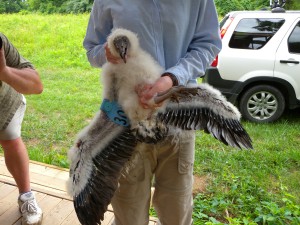
Our next PA Young Birder meeting, “Owls and their Night World”, will be held at Rushton Woods Preserve as usual, from 7-9PM on Saturday October 29. Young Birders (and their parents!) are invited to explore the enchanting night world of Rushton Woods. The exciting evening will include Northern saw-whet owl banding and a walk in the dark (no flashlights allowed, only red lights!) as we seek to understand the world from an owl’s point of view. We will gain an appreciation of the night and the creatures that own it… This month’s snack features S’mores around a campfire! Pumpkin carving is also a possibility, depending on the crop. Please RSVP to Lisa Kiziuk (lkr@wctrust.org).

Speaking of owls, has anyone heard an increase in Great Horned Owl conversations at night? I certainly have! I had the enchanting opportunity to eavesdrop on a pair of these lovely owls performing a duet in my neighborhood. Great Horned Owls are one of the few bird species of which both the male and female sings (Northern Cardinals are another example). Even though he is smaller than she, the male Great Horned Owl’s voice is much lower pitched than the female’s, and this was very audible as I stood outside in the dark listening to them. Even as all the other birds are finished with territories and breeding, October signals the beginning of the ordeal for Great Horned Owls. Males are setting up territories now, and females will choose a mate by December. They breed in late January or early February to ensure that their young fledge in the spring with the flush of rodent babies.

And for your entertainment purposes, here is a nostalgic video Lou Hahn sent me of the dramatic sequence of events in the life of a Robin parent. It’s very cute…be sure to watch until the end when the babies leave the nest unbeknownst to the father!
In addition, I hope you all are getting geared up for the movie, “The Big Year” , starring Jack Black, Steve Martin, and Owen Wilson! Audubon served as the technical advisor for this travel adventure comedy, which comes out in theatres next Friday October 14th. It’s hard to tell from the previews that the movie is about birding, but it is indeed based off of the 2004 book by Mark Obmascik, “The Big Year: A Tale of Man, Nature, and Fowl Obsession”.
Stay tuned for this week’s banding update coming to a theater near you very soon… The cold weather of this week seems to have brought a huge fallout of long distance migrating birds (including an unexpected second wave of warblers!). I’ll just give you some hints as to just how exciting this week is panning out to be: Today we caught multiple birds of 3 different species of warbler, each with ‘black’ in its name, and another special warbler was named after a state (not Connecticut-that’s old news).
No one visited us at the banding station today, but the 60 birds certainly made up for the lack of people visitors! I would come to the banding station on Thursday morning if I were you…there’s a very good chance it could be another Big Day for Rushton.
There’s a lot going on in the woods,
~Blake

